Every year I look forward to presenting the set book interviews from the graduating class at North Bennet Street School’s Bookbinding Department. However, like many events and plans for 2020, this too had to be put on hold for a later date. Over the past month and a half, I’ve had the opportunity to meet both virtually and in-person with the recent graduates. In the past, I typically got to speak with them about their work and discuss the progress of the binding in real time. Since I didn’t get the same experience this past year, I was thoroughly wowed and surprised by all of the work the graduates were able to produce over a period of uncertainty.
The set book for this group of graduates was Primo Levi’s The Periodic Table. This memoir of 21 short stories reflects on the author’s experiences as a Jewish-Italian chemist before, during and after being held captive at the Auschwitz concentration camp. With his background as a chemist, the stories are interwoven with connections to an element from the periodic table which is first introduced with the title of the chapter. As the contemplated their designs, this thread connected with some of the binders, while others chose to focus on a single portion of the book.
During the interviews, I spoke with each of the binders about their design process and how they chose to execute their vision. After missing the chance to engage with them on a weekly basis, it was wonderful to sit down and see their personalities shine through their work and the way they spoke about the process. I wish them all the best of luck in their various endeavors post graduation.
Shelley Esplin – BB ’20

One thing that I know about Shelley is that she has a love for the outdoors and is a spirited adventurer. So it was no surprise to me that she latched onto the way Levi intertwined themes of nature into his short stories. Engaged with this theme of connectivity between human and nature both on the micro and macro level, Shelley began to develop her design. She walked me through her design process and shared with me a range of ideas before settling on this typographic-style map. I find that the design is directly representing a landscape, but also gives me vibes of a fingerprint.
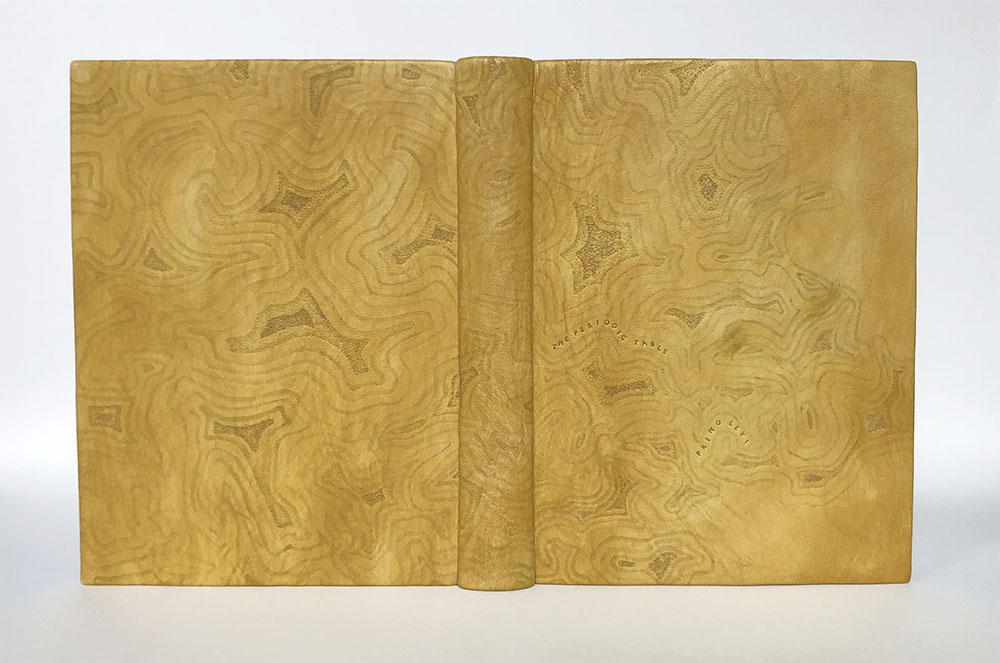
The monotone palette of Shelley’s binding intentionally highlights both the chemical process and earth tones. What is not evident in the images here, is the incredible texture she was able to add to the leather. As Shelley explained the process for creating her design it reminded me why I love conducting these interviews. I find that these students have a certain level of fearlessness that drives an ambition to create something completely new.
After dyeing a piece of fair goatskin with bright yellow Roda dye, Shelley took a special debossing plate to create this imaginative typographic map. The plate was layered with pieces of sandpaper in 5 different grits with the coarsest grit creating the deepest part of the map. Each piece was laser cut and etched with a corresponding number by Sarah Pike from FreeFall Laser. Sarah was using a Illustrator file created by Shelley to map out the pieces. Once reassembled onto an acrylic board, the damp leather protected by a layer of saran-wrap was pressed in a standing press for about an hour.
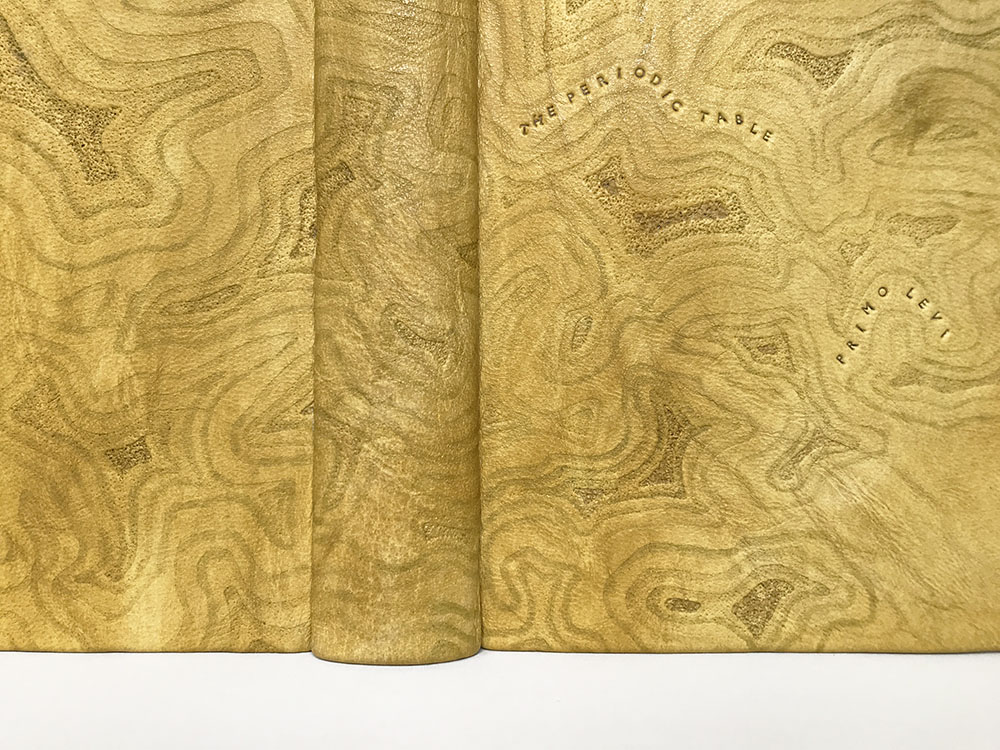
Some of the definition in the leather was lost after the binding was covered. However after doing several tests beforehand, Shelley discovered the benefit of back paring the low points to maintain some of that definition after covering. The edges were further accentuated with a bit dye brushed around the perimeter. The title and author snake around curves in the design and are tooled in Gill Sans in blind. The edge-to-edge terracotta goatskin doublures are embroidered in a gradation of yellow to brown in a design that mirrors the front cover. The doublures are opposite a suede fly leaf in apricot. The endbands play with the same palette as the embroidery on the doublures and sit over an Armenian boule edge. Shelley used her thumbprint to create texture on the edge decoration, which relates nicely to the cover design.
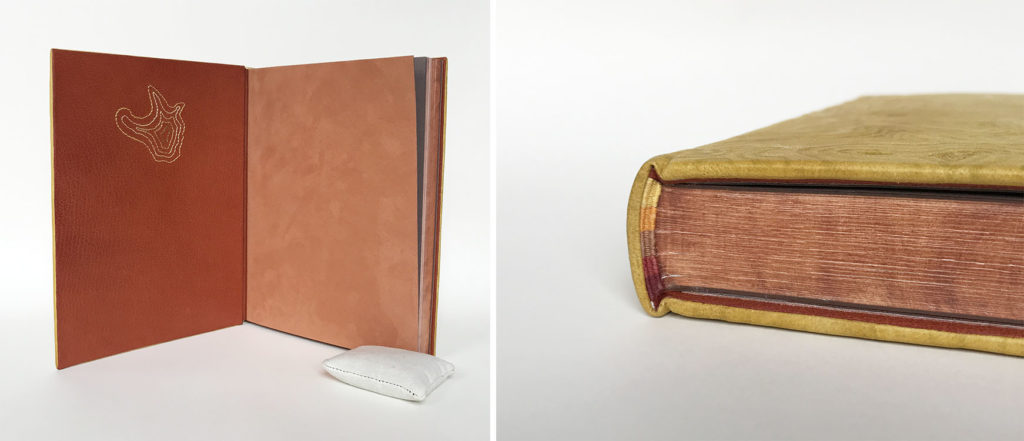
Shelley’s familiarity with laser cutting ultimately led her down this route and I love to see how binders creatively incorporate other disciplines and experiences into their work. I found so much inspiration in Shelley’s technique for creating her binding and I hope she continues blending her design background with bookbinding. I am particularly excited to see how binders engage with new technologies like laser cutting to bring something fresh to design bindings.
You can follow Shelley on Instagram @bs_collective.
Lindsay Gibbons – BB ’20
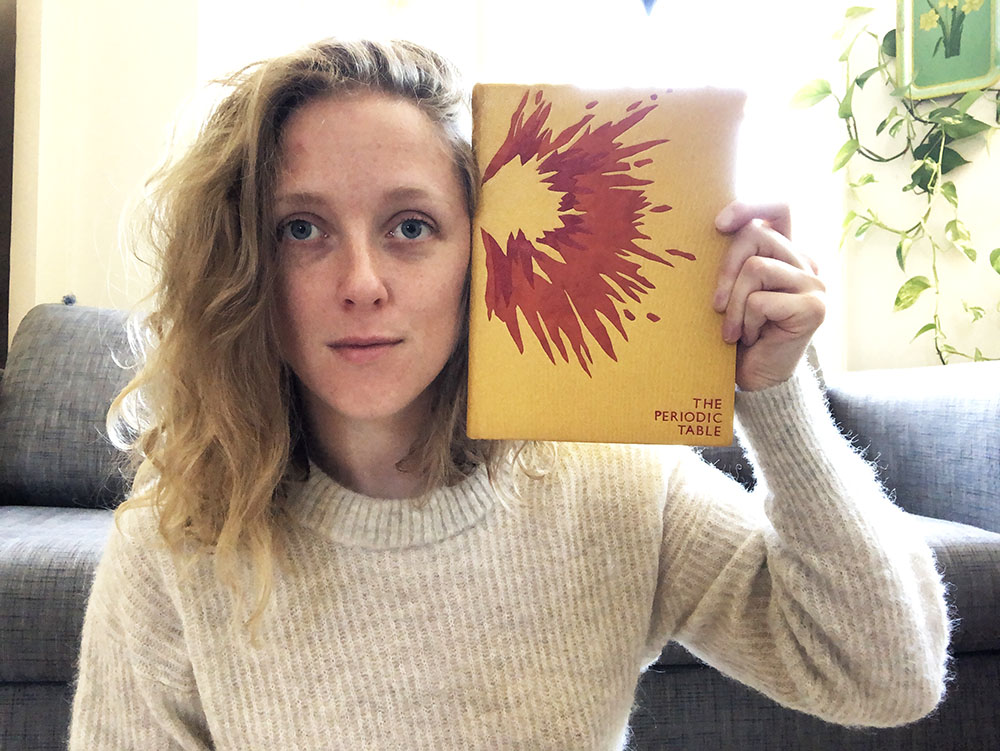
Lindsay was compelled by the progression of the story as told through inert, stable elements slowly building to the more explosive elements from the periodic table. Before landing on this concept for her design, Lindsay expressed her initial lack of interest in the text, which is a potential hurdle that we discussed during the interview. Sometime it can be difficult to draw inspiration, but Lindsay knew she wanted to create something that felt organic and contemporary. Finding inspiration from an illustration in the book, she chose a warm palette of yellow, orange and red.
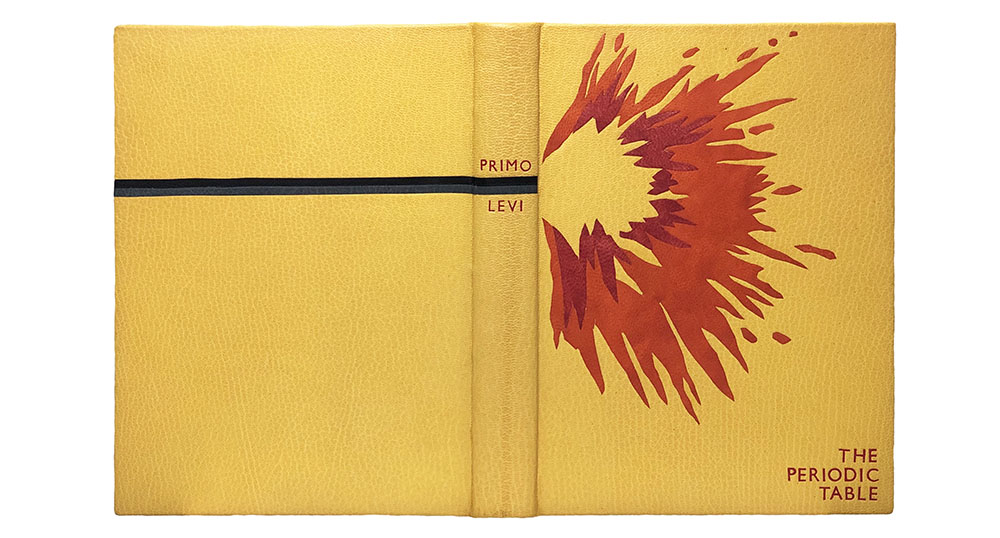
When the binding is fully opened you can clearly see Lindsay’s concept illustrated from left to right. Starting at the back cover the fuse is a pair of back-pared onlays in hand-dyed grey and black goatskin. The fuse wraps around the spine and ends right at the front cover so that it is only visible when the binding is open. The fuse also runs through the author’s name which is tooled in matte red foil. The explosion is represented with hand-dyed orange and red goatskin back-pared onlays.
Lindsay chose to hand-dye the leather for the onlays in order to control the hue of each element, in addition to creating a mottled effect for the red and orange. This texture gives the onlays that organic feel Lindsay was hoping to capture. The title is tooled in the lower right hand corner in the same matte red foil.
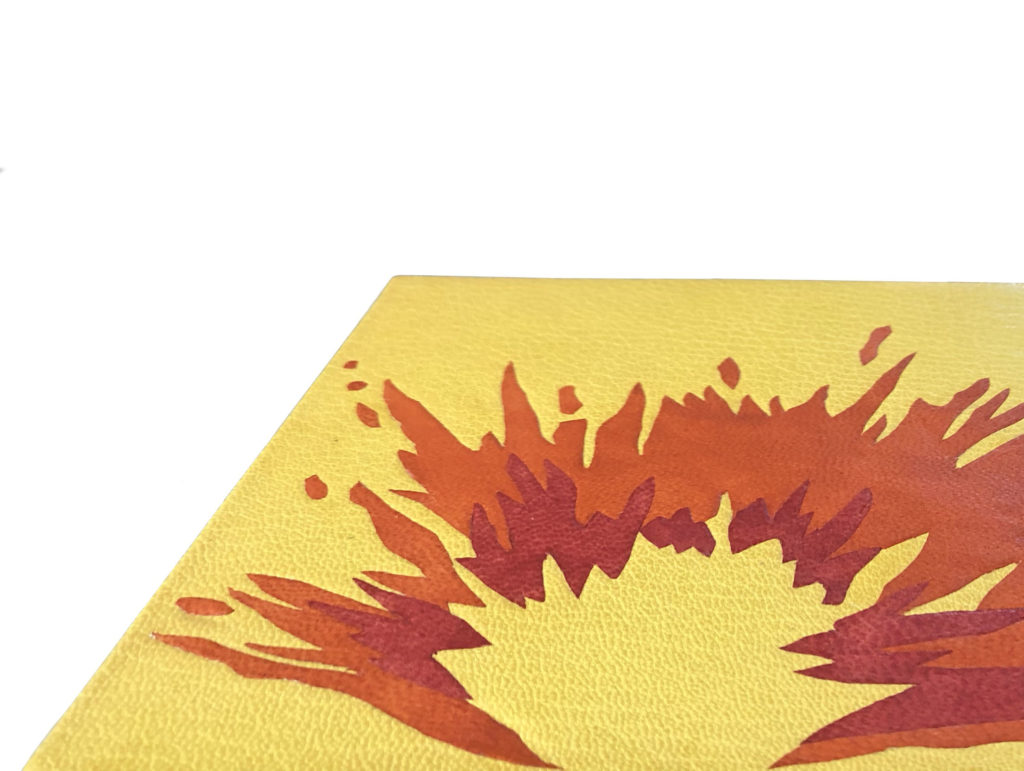
The edges of the text block are decorated with buckthorn which offers a pale yellow hue and perfectly matches the yellow variegated thread used to create the hand sewn endbands. The paste down and flyleaf bring the vibrant palette to the inside with orange Colorplan paper.
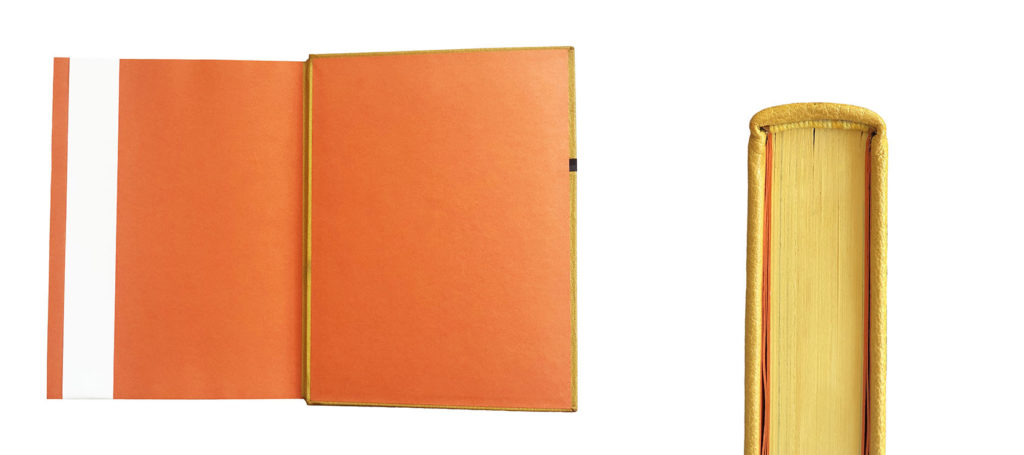
Much of Lindsay’s design was familiar to me, since we had the chance to discuss her design before the students were disrupted by the pandemic. Some aspects of the design were removed or rearranged during that span of time, but it was amazing to see her small sketch realized into this impressive and colorful binding. Towards the end of our conversation, we spoke a lot about fine bindings and creating work of this nature for exhibits and clients. I can’t to see what Lindsay decides to bind next.
Follow Lindsay on Instagram @lcgarts to find out what she’ll be doing next.
Samantha Griglack – BB ’20
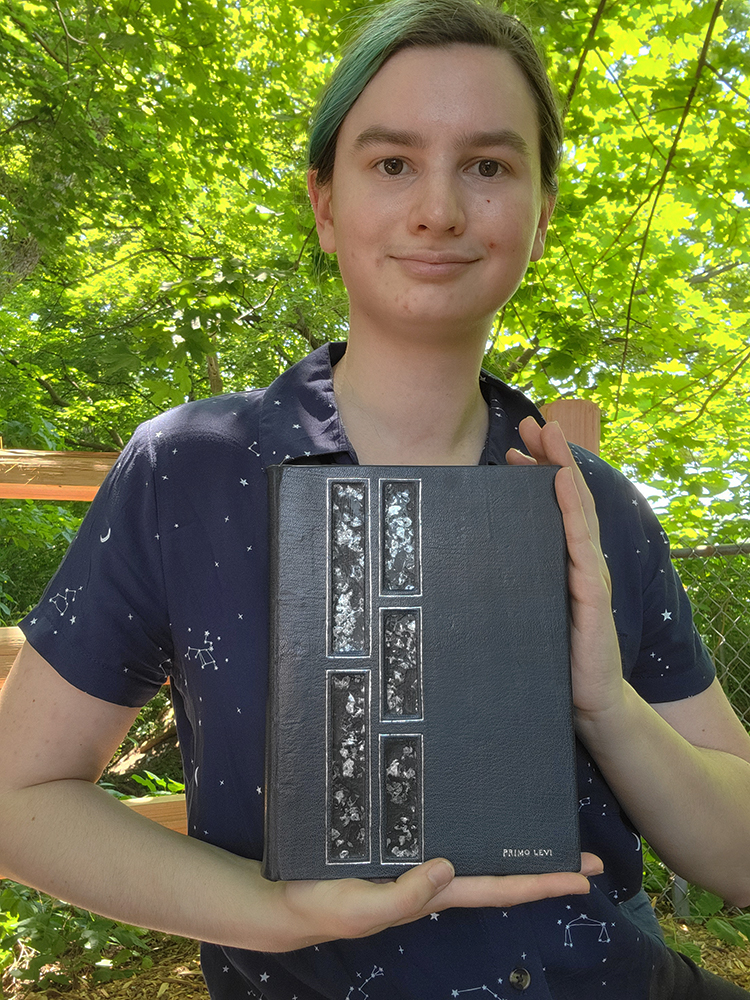
After listening through the audiobook in between a busy schedule of school and work, Sam decided that her design would create a feeling for the story as a whole. Working with a limited color palette, Sam uses navy blue and silver to highlight Levi’s Jewish faith. Meanwhile the mica pulls double duty within the design, speaking to the predominant themes of nature and chemistry presented in the short stories.
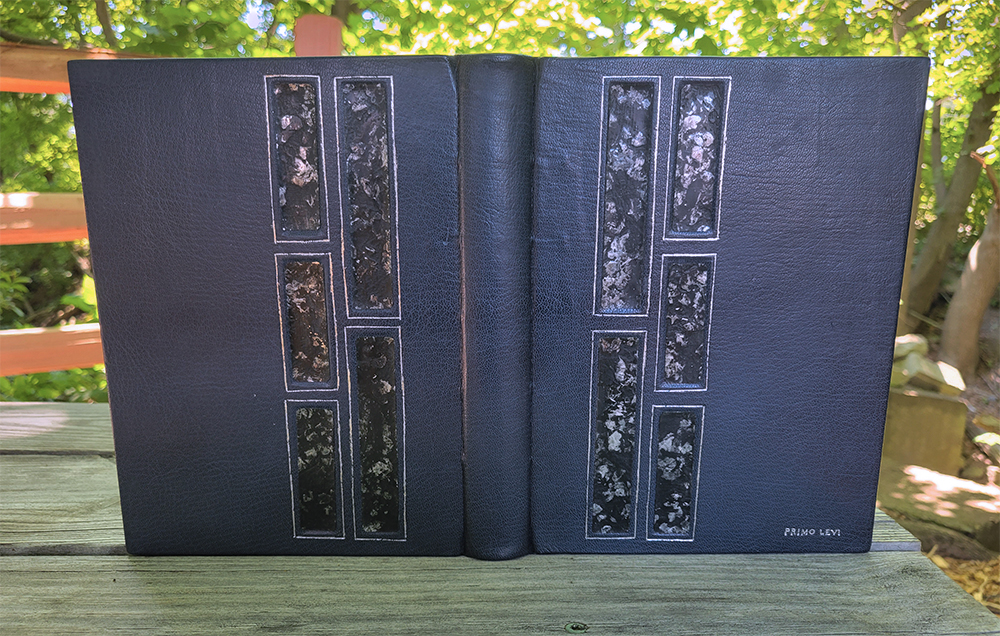
The medium blue goatskin is adorned with panels of “eggshell” mica that span each cover in a symmetrical pattern. Using the eggshell technique, Sam replaced the traditional material with sheets of mica. Working on a large sheet of paper, Sam layered on a wash of black gesso over the cracked mica before sanding. This process was continued until the right effect was achieved. The panels were sealed with wax and then cut to size before being inlaid into the covers.
Palladium is tooled as a single border around each panel and used for the author’s name in the lower right hand corner of the front cover. The palladium offers the same shimmer as the mica and is a perfect pairing to the inlays.
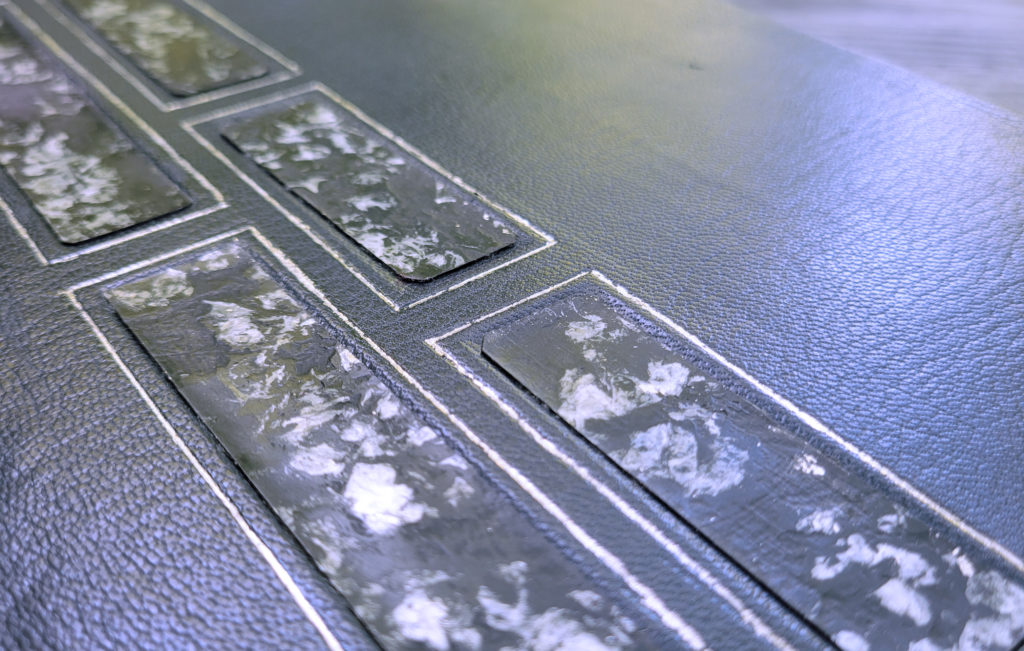
The head edge is sprinkled with palladium leaf over a graphite ground. This marries perfectly with the mica panels. The endbands are sewn in a matching blue floss with metallic fibers. The marbled paste down and flyleaves come from Pamela Smith. The over-marbled paper has a texture that mimics both the mica panels and the sprinkled edge.
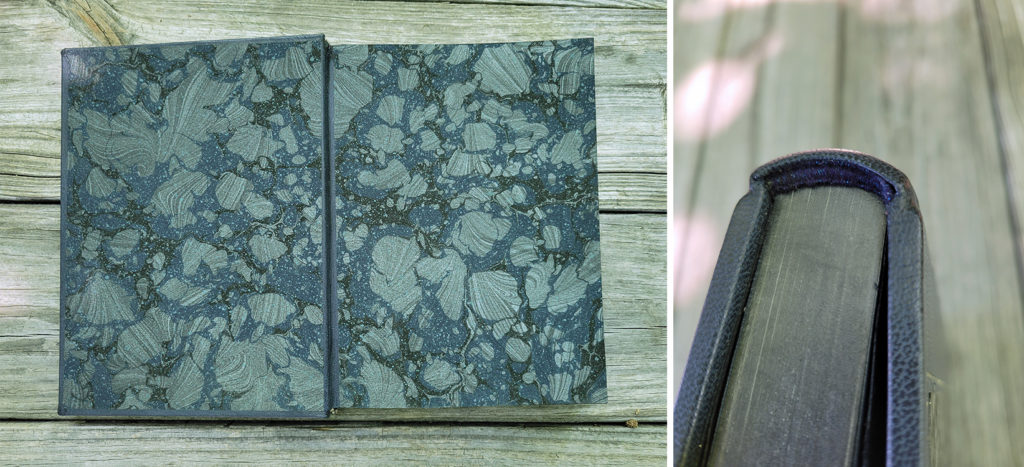
While creating a fine binding may not have been Sam’s cup of tea, her use of mica in place of eggshell is quite innovative and like nothing I’ve seen before. The organic quality of the mica panels offer a blend of light and dark, a duality threaded throughout the book. While talking with Sam, she declared a real interest in marbling which she realized during a workshop with Chena River Marblers. I can’t wait to see where she takes this excitement for marbling.
After graduation, Sam plans to build up her bindery business that sells ready-made journals, marbled earrings and other items. Follow her on Instagram @caviidaemara and check out her website: Wildwood Bindery.
Mitch Gundrum – BB ’21
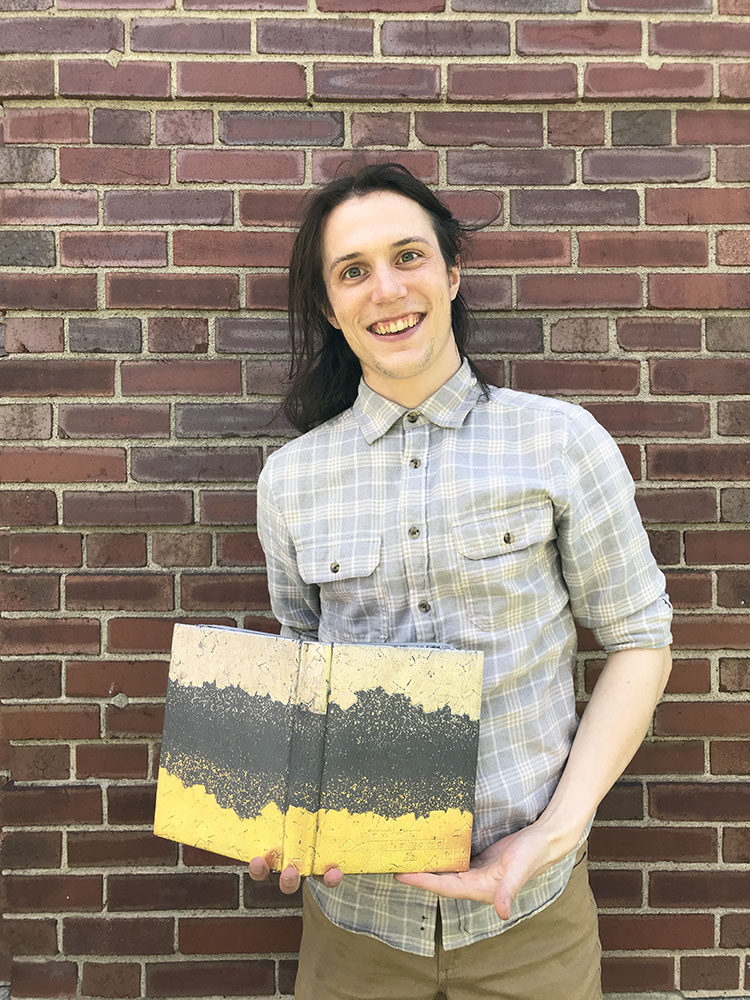
Mitch latched onto the overarching theme of duality within The Periodic Table. Levi weaves a thread of contrast throughout with presentations of chemistry and alchemy (or the idea of turning something worthless into something precious). Running with this idea, Mitch created a spectacular binding, illuminated by gold and palladium.
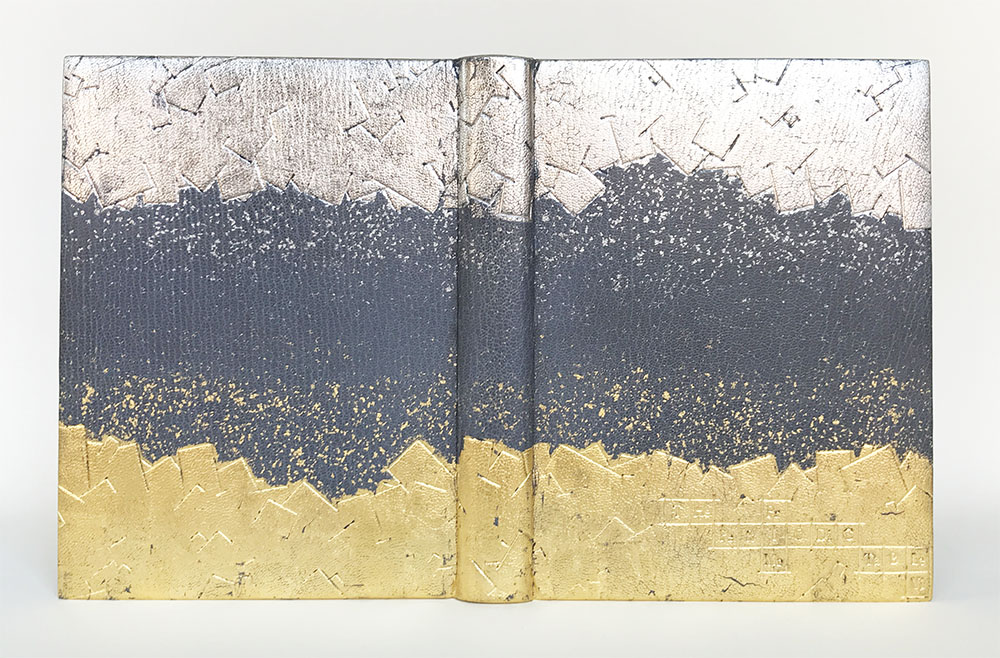
The book is covered in a gray goatskin and blind tooled with a cubic design reminiscent of minerals and crystal formations. The title was also blind tooled into the lower right hand corner before any other design elements were added. Small flecks of gold and palladium were sprinkled on their respective halves before Mitch added a layer of surface gilding. The blind tooling created a crisp edge for the leaf and offered a greater depth to the design. All areas were tooled again, which allowed the leaf to settle in and create a more defined texture to the cover.
The division of the design continues onto the edge of the text block with gilt and sprinkled layers of leaf over a ground of graphite. The cracked effect from the gilding creates a lovely organic texture to the work. The endbands blend into their corresponding edge by being sewn with gold and silver grey threads.
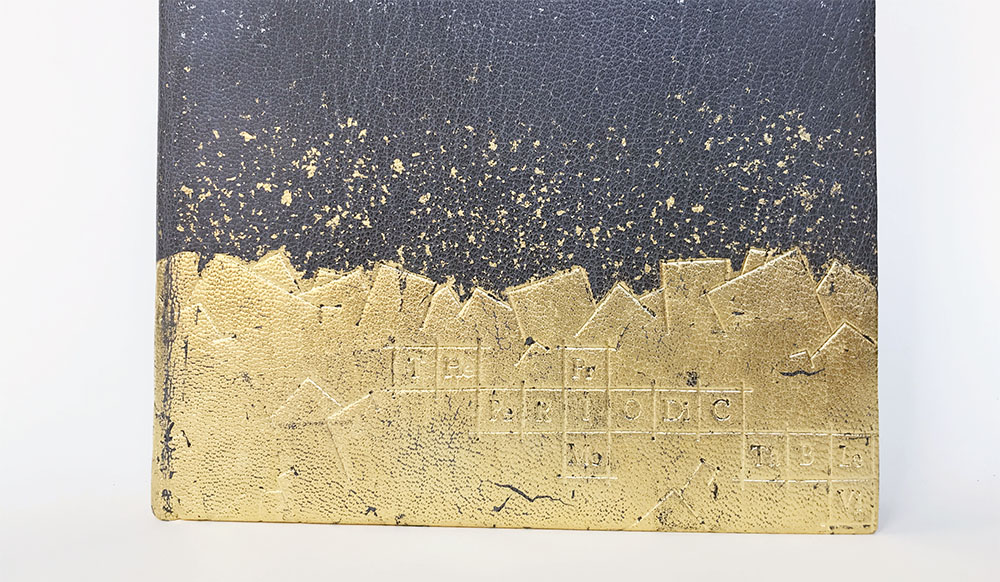
Upon opening the binding to explore the paste down, I was pleasantly surprised by the detail added to the leather hinge. Here too, Mitch has continued the design from the cover by adding layers of leaf through sprinkling and surface gilding. It’s a unique touch and not an area of the binding that is greatly utilized. The marbled paste papers perfectly match the aesthetic of the binding with threads of gold and silver running through areas of grey, black and white.
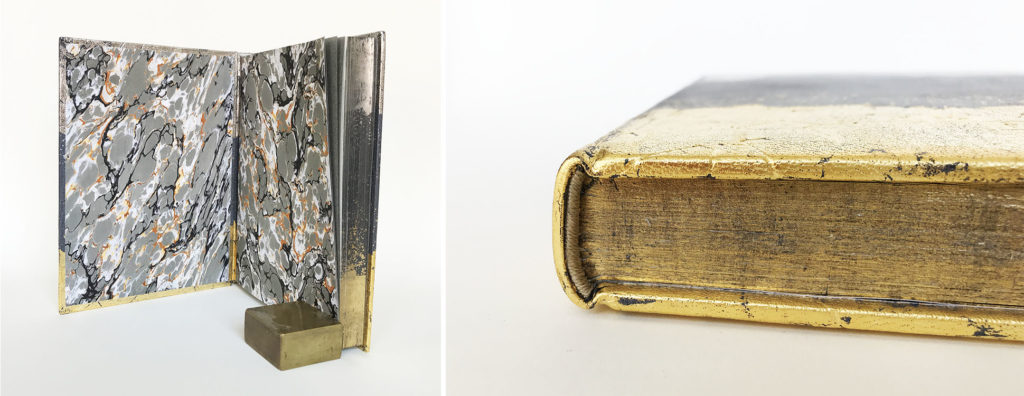
I was so excited when Mitch pulled out his binding to show me. His ambition to really play with techniques matched my own experience as a student with my set book of The Songlines. He really worked outside his comfort zone and took advantage of his time at North Bennet to explore a range of techniques on his binding.
You can follow Mitch on Instagram @a.swing.and.a.mitch and catch more of his work at Boundless. Following graduation Mitch left for D.C. to start a 3-year Conservation Technician position at the National Archives where he will be working on treatments of Civil War Era pension files slated for digitization.
Jane Knoll – BB ’21
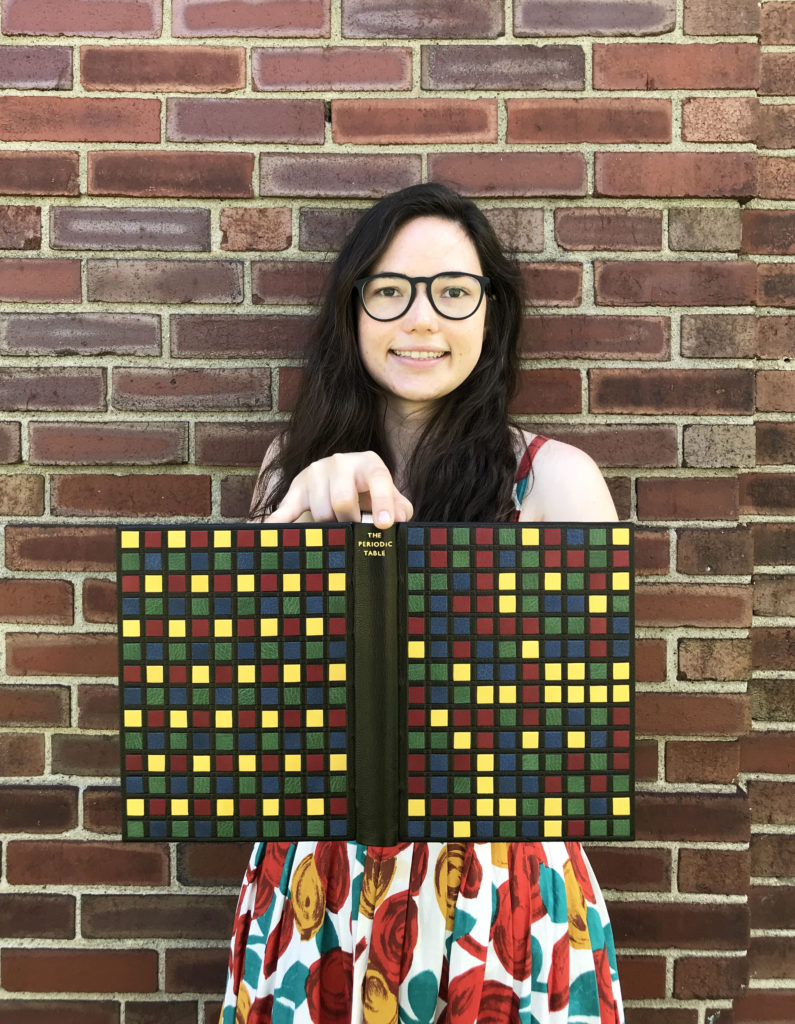
After playing with many iterations of more illustrative designs that put the focus on a single chapter from the book, Jane took a step back and decided to consider the book as a whole. The act of writing a memoir pushes one to create order among the scattered tales of their life. A good memoir threads together individual tales in order to create a greater story. This process is what inspired Jane’s design. Although the process of executing the design is quite formulaic, the covers express two very different concepts.
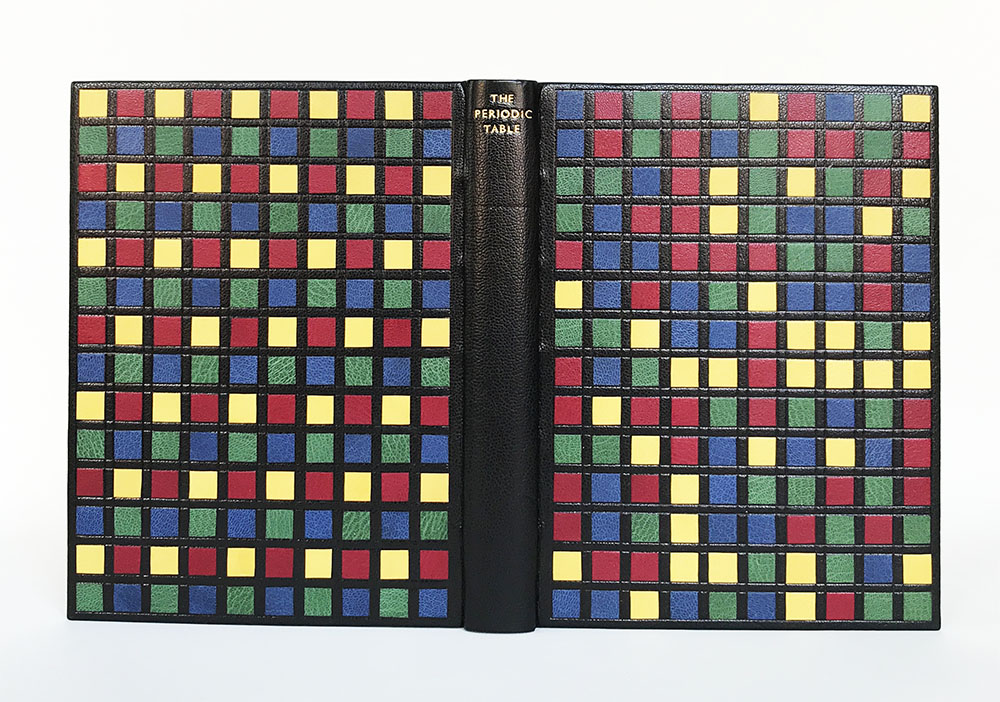
The binding is covered in a black goatskin with an overlapping grid pattern tooled in blind. The overlapping lines create an incredible texture giving this binding an even greater appeal. Each tooled onlay was meticulously cut from strips of crimson, yellow, blue and green goatskin. Row by row, the back cover is neatly arranged with alternating squares of yellow and crimson followed by squares of blue and green.
The front cover is more chaotic in the placement of the colored squares. In the process of writing a memoir the author can package their life stories in a neater and more organized fashion. Yet life is rarely carried out this way and Jane wanted to express this in her design. So Jane used a number randomizer to create the layout for the design and stayed true to the pattern until she ran out of the crimson goatskin. However, the remaining portion without crimson pieces was also randomized in order to maintain that theme of chaos. The title is gilt with gold leaf in Gill Sans and spans across the spine near the head edge.
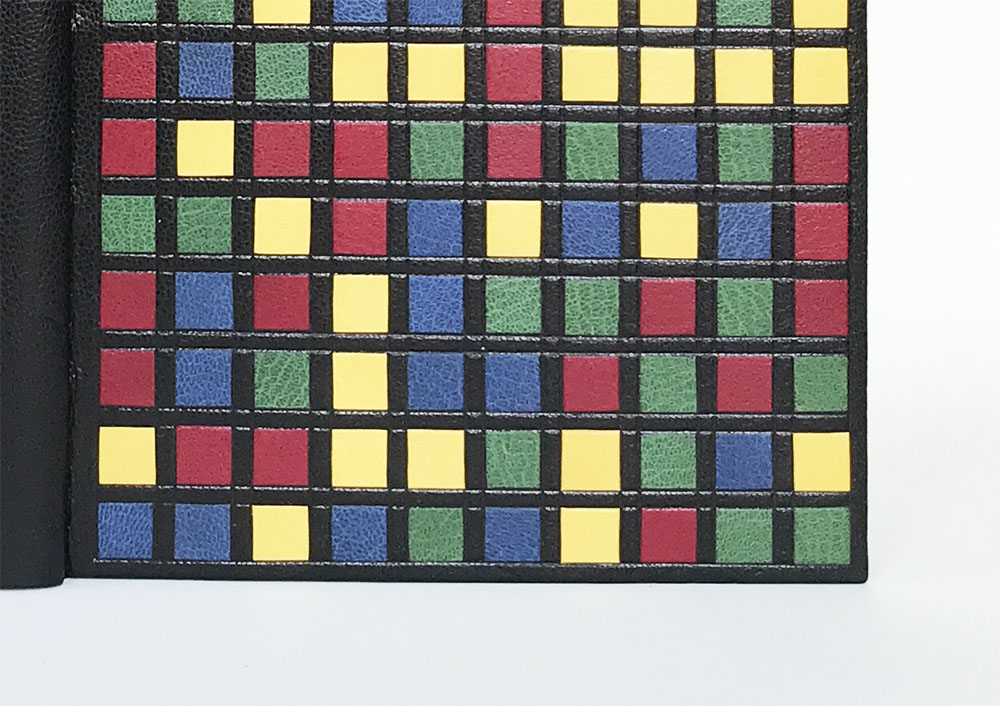
With such a bright exterior the remaining areas are left more subdued with no edge decoration and a simple endband of black with a band of red around a rectangular core. The paste downs and flyleaves are marbled papers from Dodin’s Marbling and were selected by Jane to highlight the palette on the cover.
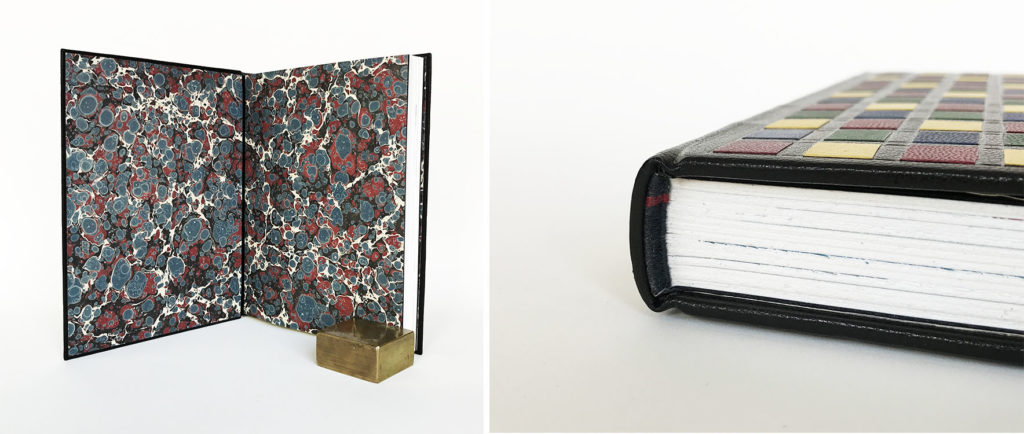
It was great to see Jane’s process for experimenting with different designs and materials. Many of her designs were explored through Photoshop, which is how she prefers to work since ideas can be manipulated quickly. The binding is superb, but I would expect nothing less from Jane. Her passion for bookbinding is apparent every time I visited North Bennet, as she always had some new treasure or discovery to share.
You can follow Jane on Instagram @mrkgnaopress and see more of her work on Mrkgnao Press. This fall, Jane will be sticking around Boston as the next Von Clemm Fellow at the Boston Athenaeum.
Mike Miura – BB ’20
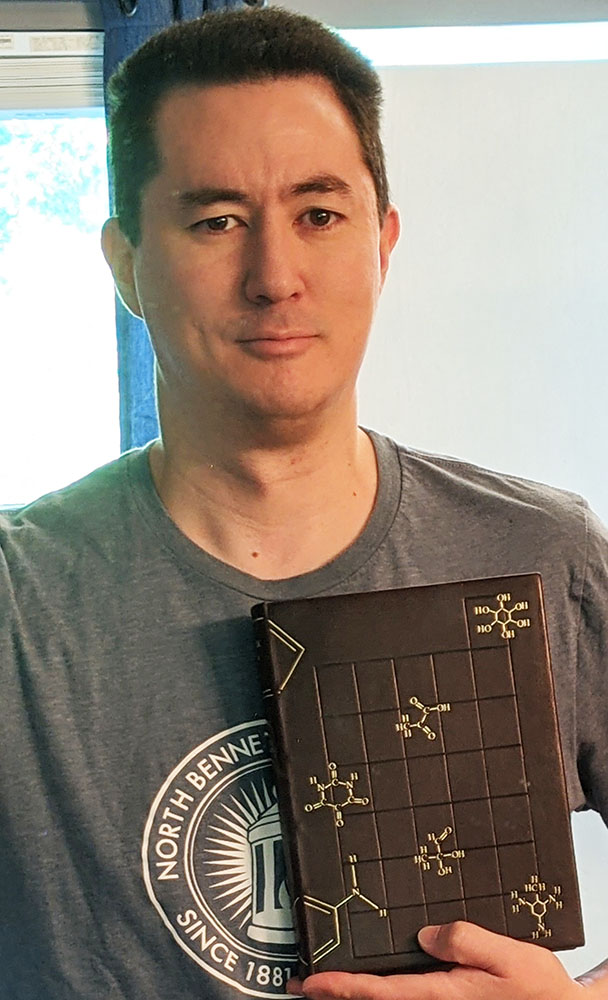
My interview with Mike was not in person as he moved back to Colorado at the start of lock down last year. He finished the remaining months of his second year remotely, but I do recall a few conversations we had regarding his design prior to this disruption. So it was a delight to finally see his binding come through my inbox. Reading through the text, Mike felt a strong desire to create a design that would play with the elements highlighted in each chapter set over that familiar layout that makes up the periodic table.
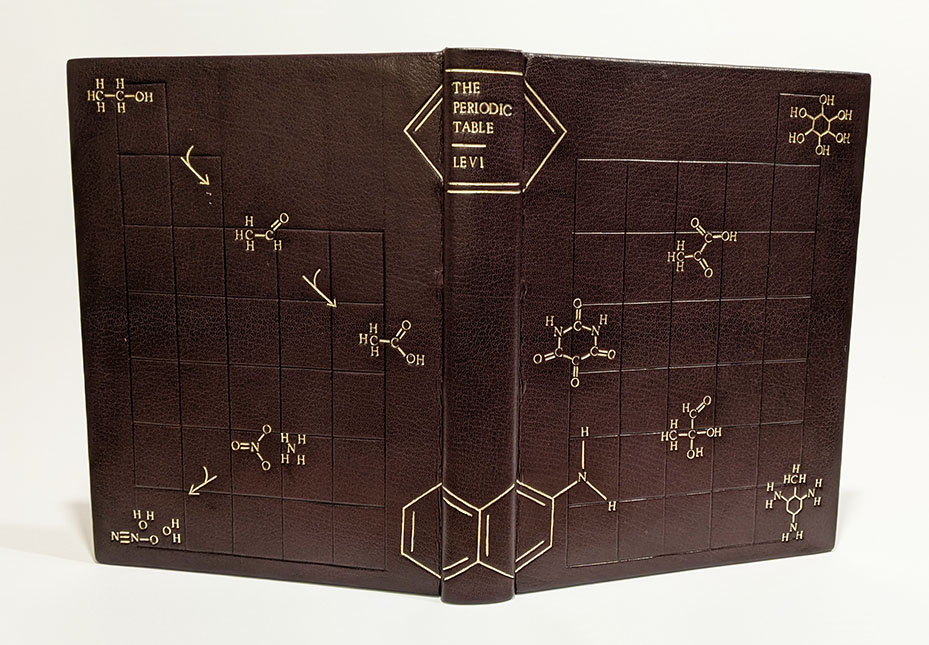
A second idea began to emerge, as Mike also jotted down the various molecules that were incorporated throughout several different chapters in the book. Upon reflection, the combination of the two designs became more than the sum of their parts. It’s no wonder with Mike’s background in science and biology for more than 12 years, that he would gravitate towards structuring his design in this way.
The binding is covered in blackberry goatskin with the periodic table blind tooled across both covers. The gold tooling shines bright against the dark purple leather and forms molecular structures that span across the binding in a triangular pattern as a means to break out of the confinements of the grid. While most of these structures are pulled from the book, Mike incorporated a few extras, such as TNT and ammonium nitrate. A nod to the explosive quality of chemistry and some elements within the periodic table.
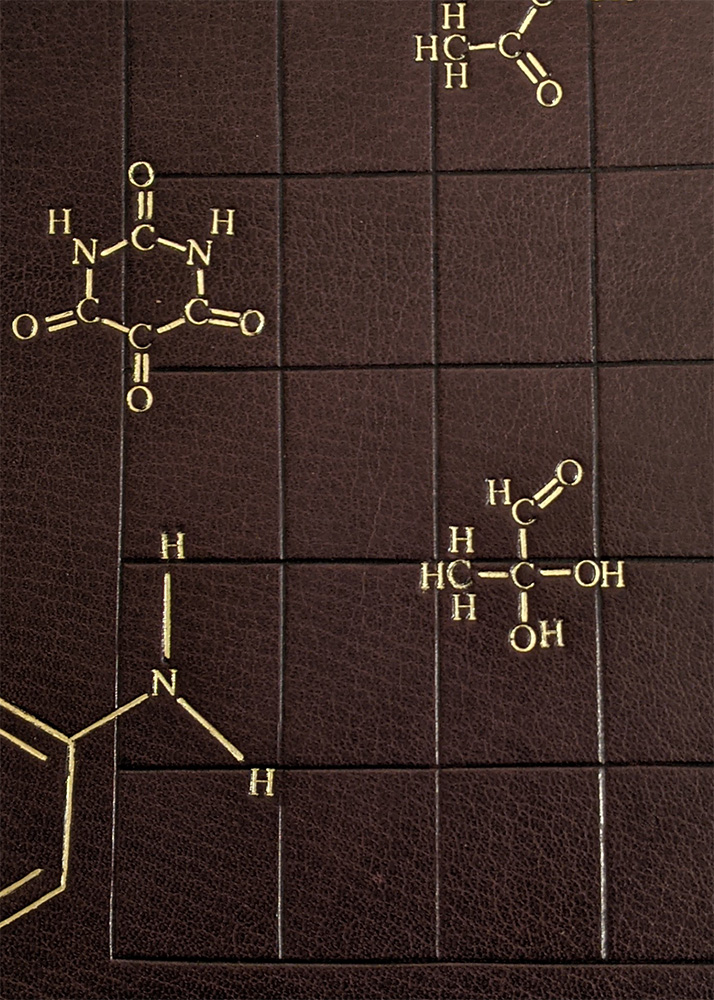
When a book has themes on chemistry, I can think of no better paper to use than marbled paper. Many of the designs are explosive with color and have an organic quality to them. So it’s no surprise that almost all of the binders chose to use it in their bindings. To counter the dark exterior of the blackberry, Mike picked a marbled paper from Claire Guillot that includes hints of dark purple between the bright shades of gold, pink and white. The use of a dark leather and bright marbled paper felt like the perfect way to showcase the darker themes in the book, while also highlighting the brightness that courses throughout. The head edge is decorated with graphite with a leather wrapped endbands in blackberry goatskin.
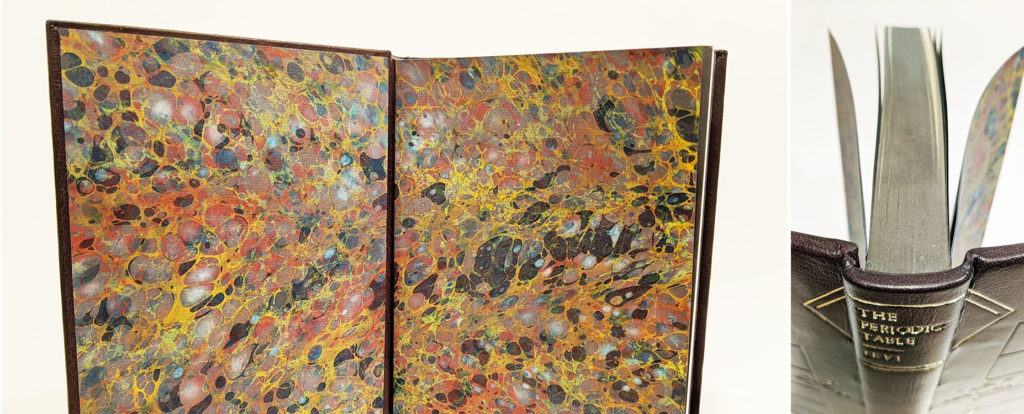
The calculated choices for these materials create a balance and give an overall feeling for the work inside. The design on the cover creates a spin on the layout of the periodic table and the inclusion of more explosive formulas plays to Mike’s humor. There is nothing to hide behind with his design and his execution of the blind and gold tooling is very clean and precise.
You can follow Mike on Instagram @mike.miura and check out more of his work at Catspaw Books. Mike plans to create his own bindery where he can continue to crafts fine bindings in addition to other binding work based on commission.
Lisa Muccigrosso – BB ’20
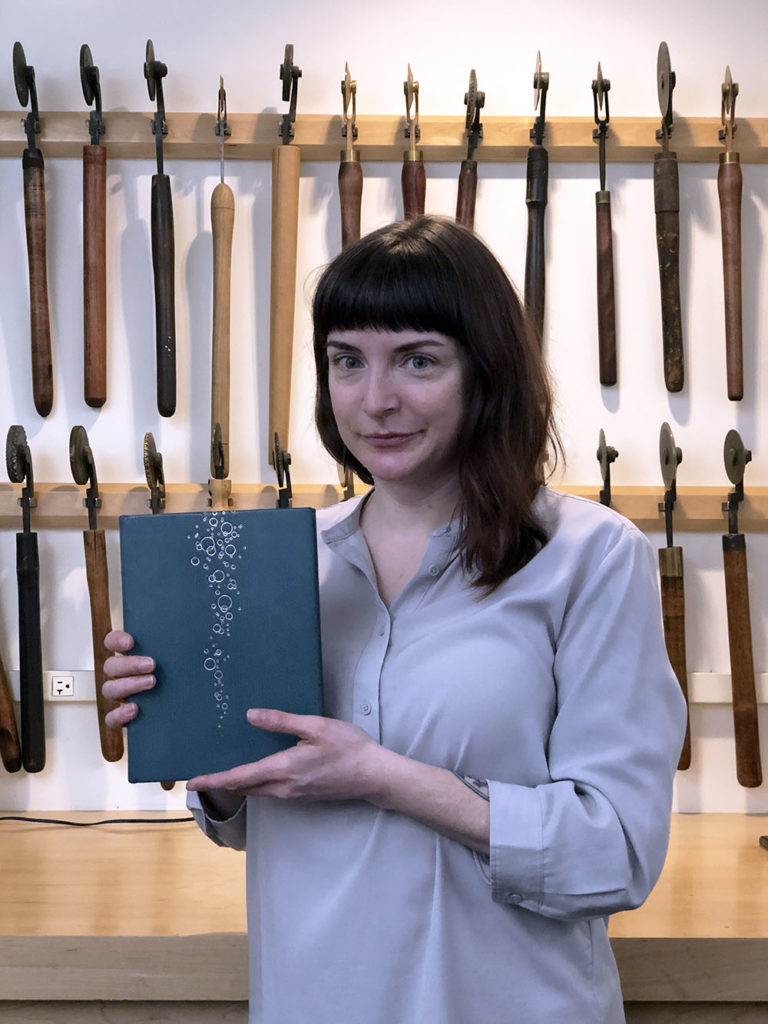
The class of 2020 had a 6-month break due to COVID between the start and finish of this project. This pause gave Lisa the opportunity to rethink and rework her design. Taking inspiration from the chapter on Zinc, Lisa wanted her design to express the catalyst that can cause behavioral changes in both people and cultures by illustrating a chemical reaction. At the time Lisa was enrolled in the course Chemistry for Conservators where she was able to witness the chemical transformation of zinc to copper.
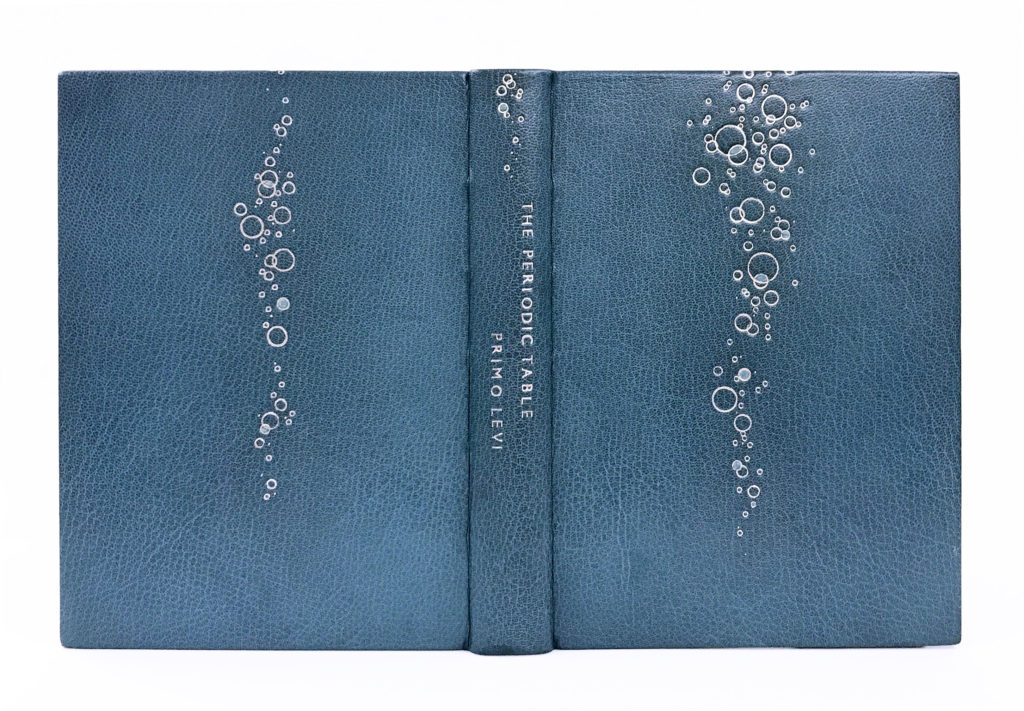
Before the final transformation to copper, the bar of zinc will run through a gradient of blue, which led Lisa to bind her book in a teal goatskin. A color she was more than happy to use. The design has a subtle interactive element: the head edge is decorated with palladium over a ground of graphite to represent the bar of zinc. So for the design to read correctly, the binding must be flipped onto its head, so that the bubbles are emerging from the head edge of the boards (or the bar of zinc). It’s a lovely and unexpected detail.
The bubbles begin at the edge of the board before flowing onto the covers and are tooled in palladium with a set of tiny dots and circle tools. It is not unheard of that a binder may react to their design as they are working and sway from their original intent. Using a tooling stencil, Lisa made slight changes here and there by adding or omitting bubbles. An organic process that also led to scraping away the grain of the leather to reveal the lighter suede underneath. This subtle change in color gives the design movement and texture.
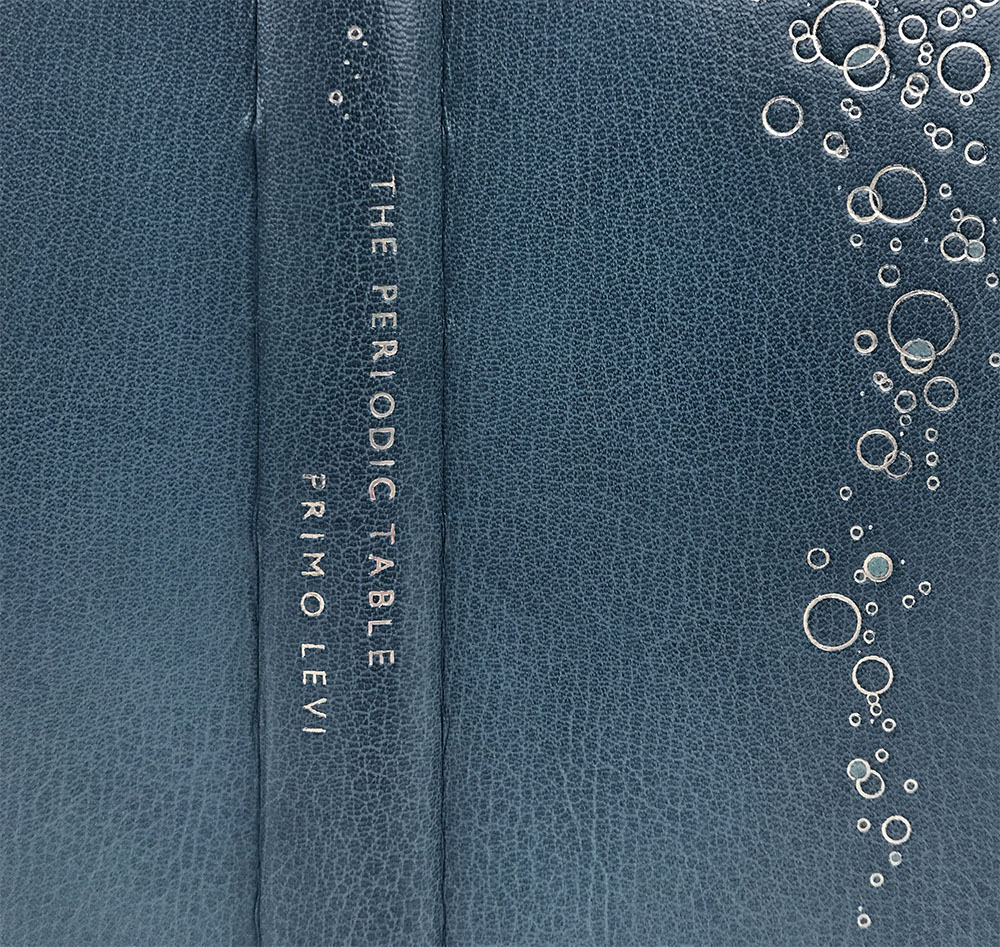
The paste down and flyleaves were hand marbled by Lisa during a workshop with Chena River Marblers and are reminiscent of a chemical reaction on a macro scale. The paper includes veins of teal and copper running through areas of black and white. The endbands are sewn in alternating bands of light grey and dark grey.
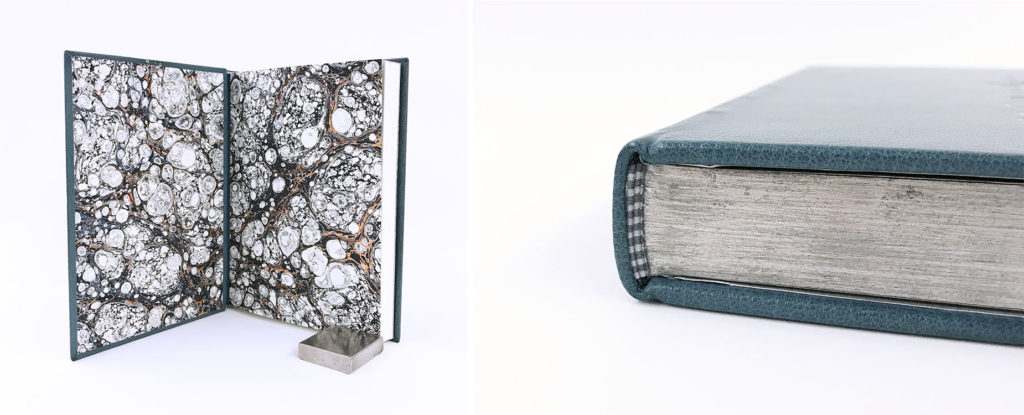
A simple design does not mean the execution was simple. In working with a pared down design, Lisa was able to put her focus on making sure each bubble was tooled to perfection and that the leather was pared evenly smooth. With no where to hide, the work has to be flawless and I think she was able to achieve that in her binding.
You can find more of Lisa’s work on her website. She is the current Von Clemm Fellow at the Boston Athenaeum and will continue in that position through the end of the year.
– – –
Thanks to the 2020 & 2021 graduating class and Jeff Altepeter, Head of Bookbinding Department. It was such a joy to get to know you all a little bit more through your work. I wish you all the best of luck in your pursuits post-graduation and how you build on your education and interests.
If you want more interviews from past classes check out the list here.

Wow! Great work all of you!